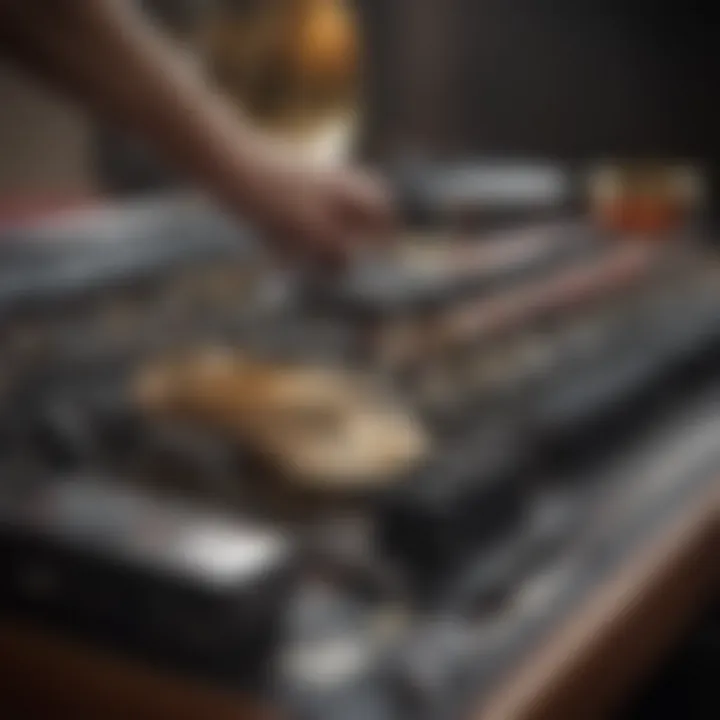Healing Music at 432 Hertz: Wellness Through Frequency


Intro
The relationship between music and healing is a topic that has piqued the interest of many. Among the various theories surrounding sound and wellness, the concept of 432 Hertz stands out. Advocates claim that music tuned to this frequency can promote emotional balance and physical healing. This article will examine the origins, implications, and applications of 432 Hertz music.
While some may approach this belief with skepticism, it is crucial to explore both scientific research and anecdotal evidence. From ancient practices to modern therapies, the exploration of 432 Hertz music reveals a rich tapestry of history and perspective. In addition, how does this frequency reflect on personal well-being? Let’s delve deeper into this captivating topic.
Foreword to Healing Music
Healing music represents a fascinating intersection of art, science, and holistic health. This genre not only serves as a source of auditory pleasure but also as a potential avenue for enhancing well-being. Interest in healing music has surged in recent years, partially due to increasing awareness of alternative therapeutic practices. Understanding the fundamentals of healing music is essential for anyone interested in the intersection of sound and wellness.
Defining Healing Music
Healing music can be defined as sound specifically composed or chosen for its therapeutic effects. This genre encompasses various forms, including ambient, traditional, and meditative music. Each piece may aim to evoke a certain emotional response, promoting relaxation, focus, or rejuvenation. The underlying principle is that sound can influence mental and physical states.
In this context, healing music often includes specific frequencies thought to resonate with the human body and mind. These frequencies can impact brainwaves, stress levels, and overall emotional health. Thus, healing music is more than mere entertainment; it serves practical purposes in mental health and alternative medicine.
The Role of Frequencies in Sound Therapy
Frequencies play a critical role in sound therapy. Sound is produced by vibrations, measured in Hertz (Hz), where one Hertz equates to one cycle per second. Different frequencies can evoke various psychological and physiological responses. Higher frequencies tend to energize listeners, while lower frequencies often promote calmness and grounding.
Through sound therapy, practitioners utilize specific frequency ranges to address various issues such as anxiety, depression, and chronic pain. The aim is often to achieve a vibrational harmony within the individual. In this regard, the idea of frequencies as tools for healing purposes is gaining substantial traction in both scientific and holistic communities.
"Frequency is the language of the universe; each sound holds a key to our emotional and spiritual well-being."
As interest in these concepts grows, the exploration of particular frequencies—like 432 Hertz—emerges. Many advocates suggest that certain frequencies possess unique properties that enhance their healing capacities. Understanding these principles lays the groundwork for a deeper investigation into the specific benefits associated with 432 Hertz music.
Understanding Hertz Measurements
Understanding Hertz measurements is crucial in exploring how sound impacts human well-being. Hertz, abbreviated as Hz, signifies cycles per second. This unit is essential for describing sound waves and their frequencies, which relates directly to how humans perceive sound. The frequency of a sound wave determines its pitch and influences its emotional and physiological effects on an individual. By grasping this concept, listeners can better appreciate the nuances of music, particularly when discussing specific frequencies like 432 Hertz.
What is Hertz?
Hertz is a standard measurement of frequency that quantifies the number of cycles a sound wave completes in one second. 1 Hertz means one cycle per second. This measurement is utilized across various fields, including physics, engineering, and audio technology. In music, understanding Hertz helps musicians and producers manipulate sound effectively. For example, an average human can hear sound frequencies ranging from about 20 Hz to 20,000 Hz. Within this range, different frequencies can evoke various emotional and physiological reactions. This understanding helps practitioners of music therapy tailor specific sound frequencies for healing purposes.
The Significance of Frequency in Music
Frequency plays a vital role in the perception of music. It impacts everything from pitch to tonal quality. The significance of frequency extends beyond mere enjoyment of music; it can affect mood, emotion, and mental state. Here are some important benefits and considerations regarding frequency:
- Emotional Response: Different frequencies can elicit distinct emotions. High frequencies may create feelings of excitement, while low frequencies can evoke calmness or sadness.
- Cognitive Effects: Studies suggest certain frequencies may enhance concentration and creativity. Frequencies often used in background music can influence productivity levels.
- Physiological Impact: Frequencies can influence heart rates and brainwave patterns. For instance, frequencies in the delta range may promote relaxation and deep sleep.
Understanding these aspects can lead to a more conscious use of music in therapeutic settings. By incorporating frequencies like 432 Hertz, practitioners and listeners alike may enhance their overall well-being.
The Hertz Concept
The concept of 432 Hertz holds a significant place in discussions around healing music. Proponents argue that this frequency aligns more closely with natural vibrations found in the universe. The idea is that when music is tuned to 432 Hertz, it creates an effect that is more soothing and harmonizing for listeners. Some suggest this frequency promotes relaxation and emotional healing. While the topic is often debated, the appeal of 432 Hertz continues to gain traction among sound therapy and wellness communities.
Historical Context
The historical context of 432 Hertz can be traced back to ancient civilizations. Many cultures, including the Greeks and Egyptians, believed in the healing properties of sound. The ancients used specific frequencies in their musical traditions for spiritual and therapeutic purposes. For instance, Pythagorean philosophy may hint at a harmonious connection between numbers and sound, including concepts around specific ratios and frequencies.
Interestingly, the link between 432 Hertz and significant historical periods does not stop there. Some theorists claim that classical composers, such as Verdi and Mozart, wrote music at 432 Hertz, although this is still debated. They argue music tuned to 432 Hertz resounds with a cosmic quality that can deeply resonate with human emotions and consciousness. Although historical evidence is limited, the allure of these claims persists, inspiring modern musicians to explore and adopt this frequency in their work.
Comparison with Hertz Standard Tuning


The tuning of musical instruments is most commonly standardized to 440 Hertz. This standard was widely adopted in the early 20th century and is still prevalent today. The shift from 432 Hertz to 440 Hertz has sparked considerable debate.
Key Differences:
- Nature of Sound: Supporters of 432 Hertz claim it is softer and more natural, while 440 Hertz can be perceived as sharper or more aggressive.
- Physical and Emotional Impact: Many individuals report feeling calmer and more centered when exposed to 432 Hertz music, whereas they might feel more tension with 440 Hertz.
- Perceived Frequency Benefits: Advocates for 432 Hertz argue it aligns better with the frequency of the Earth and the universe, promoting holistic healing effects. Critics, however, indicate that there is no substantial scientific proof supporting these claims, noting that personal experiences vary significantly.
In summation, comparing the two frequency standards enhances the ongoing dialogue about their respective impacts on listeners and the potential implications for sound healing practices.
Scientific Perspectives on Frequency and Healing
Understanding the scientific perspectives on frequency and healing provides a foundation for exploring the connection between sound and well-being. This section investigates how sound frequencies, notably 432 Hertz, impact physiological and psychological responses. By examining the underlying mechanisms of sound therapy, we reveal the potential benefits of integrating healing music into daily practices. This analysis underscores the relevance of sound frequencies within health and wellness paradigms.
Physiological Responses to Sound Frequencies
Sound frequencies can evoke profound physiological reactions. Research shows that different frequencies may influence the body's biological systems. For example, 432 Hertz is thought to resonate with physical processes in the body, promoting harmony and balance.
Here are some key points regarding physiological responses:
- Heart Rate Variability: Exposure to soothing sounds may improve heart rate variability. Studies indicate that relaxing music can induce a physiological state conducive to healing.
- Cortisol Levels: Music has been found to lower cortisol, a hormone linked to stress. Lowering stress hormone levels is essential for optimal health.
- Pain Perception: Frequency exposure may alleviate pain. Some individuals report reduced pain sensations when listening to specific sound frequencies.
Engaging with healing frequencies can cause a positive shift in bodily functions, indicating a potential therapeutic avenue worth exploring.
Research on Music Therapy
Music therapy has gained recognition in clinical settings for its therapeutic effects on mental and physical health. The field merges artistic expression with scientific principles to address various health issues.
Researchers have focused on how music can aid in recovery and enhance quality of life. Some important findings include:
- Cognitive Benefits: Music therapy plays a role in cognitive function improvement, especially for individuals with neurological conditions.
- Emotional Regulation: Various studies document how music therapy supports emotional expression and regulation. Patients report enhanced emotional stability after participating in music interventions.
- Social Interaction: Group music therapy promotes social cohesion, making it a valuable tool in rehabilitation settings.
Incorporating 432 Hertz music into therapy sessions may amplify these benefits, aligning with patients’ needs while promoting overall wellness. The merging of music therapy and healing frequencies represents a frontier in health research, supporting new methodologies in practice.
Cultural and Historical Analysis of Hertz
The study of 432 Hertz music cannot be complete without examining its cultural and historical context. Various civilizations have held music and sound as sacred elements integral to their spiritual and physical well-being. Understanding this history can provide deeper insights into why 432 Hertz is revered today and how its significance has evolved.
Ancient Civilizations and Sound
Ancient cultures recognized the power of sound in ways that modern society might overlook. Many civilizations, including those in Greece, India, and Egypt, emphasized the role of sound in spiritual and healing practices.
For example, the ancient Greeks believed in the concept of music as a form of divine harmony. They used specific musical scales for different emotional and physical outcomes. Similarly, in India, the practice of Raga and the use of specific notes, or "swaras," were significant in achieving spiritual enlightenment and healing.
Moreover, numerous ancient texts reference the use of certain frequencies to create desired effects. This lays the foundation for the belief in 432 Hertz, as it is seen not only as a frequency but as a potential medium for healing. In these cultures, sound was not just entertainment; it was a conduit for transformation and connection.
Notable Artists and Their Use of Hertz
Throughout history, several notable artists and musicians have embraced the tuning of 432 Hertz. This frequency has been associated with feelings of peace and tranquility, attracting those who seek to produce music that resonates on a deeper emotional level.
For instance, renowned musicians like Giuseppe Verdi, who contributed to the opera repertoire, advocated for tuning orchestras to 432 Hertz. More contemporary artists, such as the rock bands Yes and The Beatles, have also experimented with this tuning in their compositions. Such choices demonstrate a blend of historical significance and modern relevance.
Notably, the growing popularity of 432 Hertz among indie and new-age musicians reflects a wider cultural trend toward mindfulness and holistic well-being. These artists often market their music as healing tools, reinforcing the idea that sound and frequency can affect psychological and physical health positively.
"Music is the shorthand of emotion." — Leo Tolstoy


Practical Applications of Hertz Music
The exploration of 432 Hertz music extends beyond theoretical discussions and touches on its practical implementation. As modern life becomes increasingly complex and stressful, the integration of harmonious sound frequencies into daily routines presents a unique opportunity for enhancing overall well-being. Understanding how to effectively incorporate 432 Hertz music into various aspects of life can maximize its potential benefits for both mental and physical health.
Incorporating Hertz into Daily Life
Integrating 432 Hertz music into daily life can be done through various methods that accommodate individual preferences and lifestyles. Some meaningful ways to do this include:
- Listening while working: Background music set at 432 Hertz can enhance focus and reduce anxiety. Many users find that it promotes a flow state during tasks like writing or coding.
- Setting the mood at home: Playing this frequency during family meals or gatherings can foster a calming atmosphere. It encourages harmonious interactions among family members and friends, making social interactions more pleasant.
- Creating relaxing spaces: Use 432 Hertz music in personal spaces, such as a reading nook or meditation corner. This can help in establishing an environment conducive to relaxation and reflection.
The act of consciously choosing and incorporating 432 Hertz music into daily tasks can influence emotional responses positively. By using this frequency, individuals may experience improved clarity of thought, reduced stress levels, and an increased sense of calm throughout the day.
Hertz in Meditation Practices
Meditation practitioners often seek tools to deepen their experience. Incorporating 432 Hertz music can augment meditation practices in several key ways:
- Enhancing focus and mindfulness: This peaceful frequency can assist in attaining a meditative state by minimizing distractions. The sound has a natural resonance that may allow practitioners to concentrate more effectively on their breath and thoughts.
- Facilitating relaxation: The soothing properties of 432 Hertz music help lower stress levels. Many practitioners report that it allows them to enter more profound states of relaxation and expands their inner awareness.
- Guiding the journey inward: Many meditation sessions utilize specific music tracks to help guide users through their experiences. Selecting tracks tuned to 432 Hertz can create a backdrop that aids in emotional processing and self-discovery.
In sum, both daily incorporation and meditation practices benefit significantly from the use of 432 Hertz music. As individuals become more conscious about their sound environment, the potential for holistic engagement with this frequency continues to expand, offering pathways to increased well-being and personal growth.
Anecdotal Evidence and Personal Experiences
Anecdotal evidence and personal experiences play a significant role in understanding the impact of 432 Hertz music in healing. While scientific research provides valuable information, the subjective experiences of individuals often reveal insights that formal studies may overlook. These accounts can reflect the emotional, psychological, and physical effects of listening to music tuned to 432 Hertz, contributing to the ongoing discourse surrounding its healing potential.
Many individuals report feelings of calmness and rejuvenation when exposed to music at this frequency. Such experiences may be important for those exploring sound therapy and looking for alternative methods to manage stress and anxiety. Furthermore, anecdotes often serve as a bridge connecting personal experiences with broader themes found in the theory of music’s impact on well-being.
Incorporating these stories into our understanding allows for a holistic approach to sound therapy. Anecdotal accounts often highlight specific situations where 432 Hertz music acted as a catalyst for healing. This can include instances of emotional release during meditation sessions or improved focus in creative processes.
This section will delve deeper into specific case studies and testimonials from practitioners. By examining these narratives, we aim to illustrate the diverse ways in which 432 Hertz music can influence human experience and well-being.
Case Studies in Sound Therapy
In the realm of sound therapy, practical applications of 432 Hertz music emerge through compelling case studies. For instance, a notable case involved a group of participants who engaged in a sound therapy session focusing on 432 Hertz frequencies. Participants reported various improvements in mental clarity and emotional stability post-session. This aligns with the theory that certain frequencies can potentially enhance cognitive functions and overall mental health.
Another case study involved individuals suffering from insomnia. After several weeks of listening to music at 432 Hertz before bedtime, many experienced more profound sleep and fewer disturbances during the night. Such experiences demonstrate the frequency’s potential to facilitate deeper states of relaxation and improve sleep hygiene.
Testimonials from Practitioners
Practitioners of sound therapy frequently share their observations about the benefits of using 432 Hertz music. Many report observing noticeable shifts in their clients' mood during sessions. For example, one therapist noted that clients often described a sensation of lightness or emotional cleansing when exposed to this frequency.
“Many clients express feeling a deeper connection to themselves through 432 Hertz music,” explains a sound therapist based in New York. She elaborates on how this frequency resonates with clients seeking to explore personal healing journeys.
Another practitioner pointed out that musicians and artists often gravitate towards 432 Hertz music for enhancing their creativity. This finding coincides with the many testimonials indicating that such music can help facilitate creative thinking and artistic expression.
Controversies and Criticisms
The discussion surrounding 432 Hertz music is laden with debates and critiques. This section will explore key arguments concerning its efficacy and the skepticism that is prevalent in scientific discourse. It is vital to examine these controversies to gain a balanced understanding of healing music and its impact on well-being.
Debates around the Efficacy of Hertz
Proponents of 432 Hertz music claim that it can foster healing, reduce anxiety, and even enhance meditation practices. They state that this particular frequency resonates with the natural rhythms of the universe. However, critics argue that these claims lack substantial empirical support. They often point to the predominance of 440 Hertz tuning, which is standard in the music industry. Some studies suggest that while individual experiences may vary, there is no solid scientific proof to demonstrate that 432 Hertz is inherently superior to other frequencies.
Anecdotal evidence can sometimes skew perceptions. Personal testimonials tend to emphasize positive experiences with 432 Hertz music. But, they often do not meet rigorous scientific criteria for validation.


Additionally, discussions often revolve around subjective experiences of listeners. These experiences are valid but do not translate into universally applicable or scientifically demonstrable benefits.
Skepticism in the Scientific Community
The scientific community remains largely skeptical about the supposed benefits of 432 Hertz music. Many researchers assert that while music does influence emotions and physiological responses, the specific claims about 432 Hertz are yet to be conclusively proven. The skepticism stems from the lack of controlled studies that isolate the frequency's effects from other variables, such as musical genre or lyrical content.
Some scientists argue that the fascination with 432 Hertz may be more of a myth or placebo effect than a measurable phenomenon. They emphasize the complex ways in which sound affects human beings, suggesting that it is not merely the frequency that matters, but the overall context in which the music is experienced.
In summary, while there are compelling personal stories and a growing interest in sound therapy, the academic stance remains cautious. Scientific validation is essential for the claims surrounding 432 Hertz to gain wider acceptance and credibility.
"Music, as we know, can be a powerful tool for emotional and physical well-being, but claims must be substantiated by rigorous research to stand the test of time."
Despite the controversies, the allure of 432 Hertz continues to attract those seeking alternative healing modalities.
Future Directions in Research
The exploration of healing music, particularly that resonating at 432 Hertz, is still an evolving field of study. As we move forward, it is essential to identify the emerging trends and the intersection between technology and sound therapy. These areas promise increased understanding and potential applications of sound frequencies in health and wellness.
Emerging Trends in Sound Healing
Recent years have witnessed a significant resurgence in interest regarding sound therapy. The idea that specific frequencies can foster healing has gained traction in therapeutic communities. This trend is characterized by an increasing number of workshops, seminars, and rehabilitation programs focusing on sound healing. More practitioners are now incorporating 432 Hertz into various forms of therapy.
Consider the rise of sound baths. In these sessions, participants relax while being immersed in the soothing sounds of instruments tuned to 432 Hertz. Many report increased relaxation, reduced anxiety, and improved mood after such experiences. This anecdotal evidence is too compelling to ignore, indicating a need for systematic research into its effects.
Additionally, there has been an exploration into the use of 432 Hertz music in different cultural settings. From holistic health practices to traditional healing methods, integrating this frequency aligns with ancient beliefs about sound and its impact on well-being. The academic community should explore these integrations further, using them as case studies for broader acceptance in medical fields.
Intersection of Technology and Sound Therapy
Innovation in technology has opened new avenues for sound therapy. Mobile applications providing access to 432 Hertz music allow individuals to experience its benefits in the comfort of their homes. These technologies can play a pivotal role in self-administered therapy, making sound healing more accessible.
Moreover, advancements in audio engineering can help create enhanced sound experiences. In particular, high-fidelity audio equipment ensures that the unique qualities of sounds at this frequency are preserved. This is important for those who embrace sound therapy seriously.
Research also needs to investigate how technology can aid in diagnostic purposes. Wearable devices that monitor physiological responses could provide valuable data on how sound frequencies influence health markers such as heart rate and stress levels.
In summary, the future of 432 Hertz healing music research is promising and multifaceted. By embracing emerging trends and harnessing technology, practitioners and researchers can deepen the understanding of sound as a therapeutic tool. This evolving landscape will ultimately contribute significantly to the field of holistic health, allowing for a more integrated approach to wellness.
End: The Evolving Landscape of Healing Music
The exploration of healing music, particularly at 432 Hertz, reflects a significant shift in how we approach wellness and sound. Understanding this frequency's historical, cultural, and scientific dimensions offers insight into its potential benefits for mental and physical health. As the conversation around healing music evolves, it encourages both practitioners and enthusiasts to reconsider traditional approaches to therapy and mindfulness.
Summarizing Key Insights
Throughout this article, we have delved into various aspects of 432 Hertz music. Key insights include:
- Historical Significance: The use of 432 Hertz has roots in ancient civilizations, suggesting a longstanding belief in its healing properties.
- Scientific Basis: Physiological responses to sound frequencies indicate that music can influence emotional and cognitive states.
- Cultural Relevance: Artists from different backgrounds have embraced 432 Hertz, promoting its integration into modern music.
- Practical Applications: Incorporating this frequency into daily life and meditation can enhance mindfulness and relaxation.
These points illustrate that 432 Hertz is not merely a trend; it represents a broader understanding of how sound can be harnessed for healing.
Implications for Music Lovers and Practitioners
For music lovers and health practitioners, the implications of utilizing 432 Hertz music are profound. The continued research into sound therapy could result in new methods for enhancing well-being.
- Personal Well-Being: Individuals may consider integrating 432 Hertz music into their meditation or relaxation routines, potentially experiencing improved mental clarity and emotional balance.
- Professional Practice: For practitioners, adding 432 Hertz music to therapy sessions could offer an additional layer of support for clients seeking relief from stress and anxiety.
Moreover, the interest in this frequency can foster community among like-minded individuals, allowing for shared experiences and knowledge in healing rituals. The evolving landscape of healing music underscores the importance of blending traditional wisdom with contemporary practices, ultimately enriching the journey towards well-being.
"The power of sound is often underestimated; understanding and utilizing frequencies like 432 Hertz can open doors to new forms of healing."
As we move forward, further research and dialogue about sound, health, and healing will be crucial in shaping our approach to well-being.





